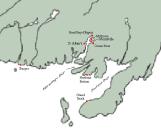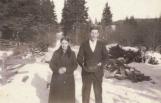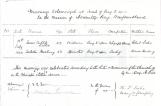1
Throughout the late 17th and early 18th centuries, records of the area are sketchy. When Captain James Cook visited the area in 1763 to do a survey he noted no evidence of settlement in the area previous to that time. By 1835, merchants started to show an interest in the Bay d'Espoir forests. Newman and Company, from England, originally came to Newfoundland to trade fish but made more profit from the goods they sold to fishermen. Newmans employed the first crews to cut wood in the area to make barrels and other supplies for the fishermen. These crews only temporarily settled in the area for the winter, but they weren't the only settlers that visited the area.3
Some families from the South Coast especially those living at the mouth of Hermitage Bay, apparently had made a practice of wintering in the Bay d'Espoir forests in the early 19th century. They moved before winter to locations in the vicinity of river mouths and other areas of level or gently sloping land by the sea that supported the tree species and sizes needed. In addition to being more sheltered than the exposed coastline, the area had resources helpful for winter survival. It was near a source of firewood and the winter settlers could also draw on the land. They hunted caribou for meat, trapped and had a chance to produce forest products for barter with merchant crews. Hoops, staves, shingles and saw logs could be traded for food and fishing supplies.5
Usually families that came into Bay d'Espoir to log only stayed for one winter because they primarily came to cut logs to build houses in their home fishing settlements. Oral tradition asserts that at least five families returned annually for ten to fifteen years before settling permanently in 1870. But in 1866, it is noted that William Barnes was the first permanent settler of Head Bay d'Espoir. William Barnes, born in Sommerset, England, came to Newfoundland to fish for Newman and Company. When he was fourteen he ran away from home when he feared punishment for mistakenly cutting down some of his neighbours hedge. He joined a group of 80 boys who were enroute to Newfoundland on a Newman's fishing company ship. William was first working in Harbour Breton with other ‘English youngsters' then later moved to Gaultois where he continued to work for Newmans. During this time, William started to visit Bay d'Espoir as a cook for Newman's logging crews. He spent a number of years wintering in the Bay d'Espoir forests. Through these visits William became familiar with the area and in 1866 settled in Head of Bay d'Espoir.The incentives for settlers to live permanently in Bay d'Espoir varied to some extent. Many wanted to practice basically subsistence farming, lumbering, hunting and trapping while they continued with the commercial fishery, although on a reduced scale. Having been a farmer's helper in England, William focused on farming to make a living. He had a 23-acre farm with dairy cattle. Eventually he owned his own schooner and marketed his butter to St. Pierre. William died in 1919 at the age of 91.


